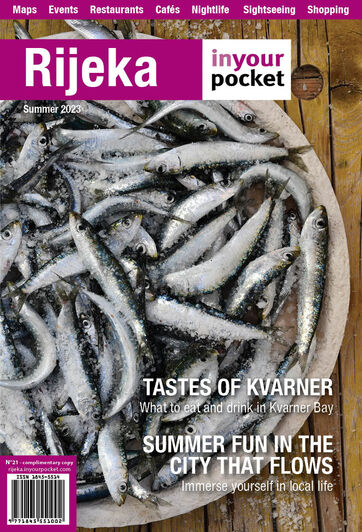The city market
Since Rijeka is a coastal city it’s no surprise that the fish market has always been highly important, and the site of today’s market is the spot where fishermen have unloaded their catch for centuries. A covered fish market has been here since 1866, and as the city has grown it has periodically been rebuilt to accommodate the needs of the population. The structure you see today dates from 1916. It’s built in an Art Nouveau style known as the secession style after the artistic movement founded in 19th century Vienna by Gustav Klimt and a bunch of like-minded artists. Of the three market pavilions it’s the one which most clearly still shows its original structure.
However, the fish market is very far from being a still life: it’s usually thronging with people, as Rijeka’s citizens do love their fish. The trays of fish laid out are quite a sight: full of silvery sardines, squid and pink Kvarner scampi, there’s a chaotic symmetry about it which is a favourite subject for photographers.
The other two market pavilions date from 1880 and are interesting for their iron construction which was pretty forward-thinking for the time, a herald of the industrial age. In one you’ll find fresh and dried meats, while the other is for dairy produce.
For lovers of good food one fine thing about the market is you can still find smallholders selling their own produce. Look out for bars of butter made at small dairies in whimsical floral moulds, and yogurt, milk and great cheeses from a goat farm on Krk island. In the meat section you’ll find hand-made dried sausages and local pršut, while the ladies on the upper floor sell home-made cheeses and other bits and pieces. We recommend you try this home-made food. It’s what the locals value most; these are the flavours they remember from childhood.
Outside is where the fruit and vegetables are on sale. Here it’s a free-for-all between traders selling imported goods, local farmers, and ladies with just a few items from their gardens at home. This again is where you find the interesting stuff. Instead of industrially-grown lettuce you can buy handfuls of young lettuce leaves, shaded and speckled with burgundy and pink, tenderly bitter; delicate lamb’s lettuce, peppery rucola and baby radiccio leavs.
In springtime you might see medveđi luk – wild garlic leaves, which are absolutely delicious lightly cooked or in salads. But do be aware that a stray lily-of-the-valley leaf or another impostor that finds its way in can cause fatal poisoning – unfortunately it does happen.
Another spring treat with health-giving properties is asparagus – both the garden variety and its slender wild cousin, which has a stronger flavour. Locals like to lightly blanch it or fry it and serve it with eggs.
Dried figs, glistening olives from an old lady’s garden… Sensuous cherries to cool you in summer… Locally-grown citrus fruits that render the whole kitchen a scented paradise… And those little stalls with odds and ends that become your favourites… intensely-flavoured herbs that make wonderful teas; delicious, locally-produced honey… Once you’ve tried the market, there’s no going back. It’s an addiction, a necessary condition for life.
Then there’s the flower market by the theatre, the barometer of the changing seasons, and the stalls in the side streets selling clothes and handy accessories. Look out for the many-strutted windproof umbrellas designed to withstand the fierce north wind, the infamous bura, essential if you’re in town in the winter.
And let’s not forget the cafés and the fast-food eateries. With folks up and about from the early morning, a cup of coffee is an essential part of the day. The cafés around the market buzz with atmosphere as locals, stallholders and shoppers alike, stop for a pick-me-up and catch up with the morning’s gossip. This is where you can feel the beating heart of the city, a sense which no tourist guide can convey.
The market is open daily from 07:00 to 14:00, and ‘til noon on Sundays. Do go and enjoy the seasonal produce from the whole region, its highlands and islands, and the equally colourful mix of people. Elderly people, young people, working people who grow the produce on sale, men and women. It’s the real Rijeka.
Refine your search
Choose Categories
Food Markets
Submit




